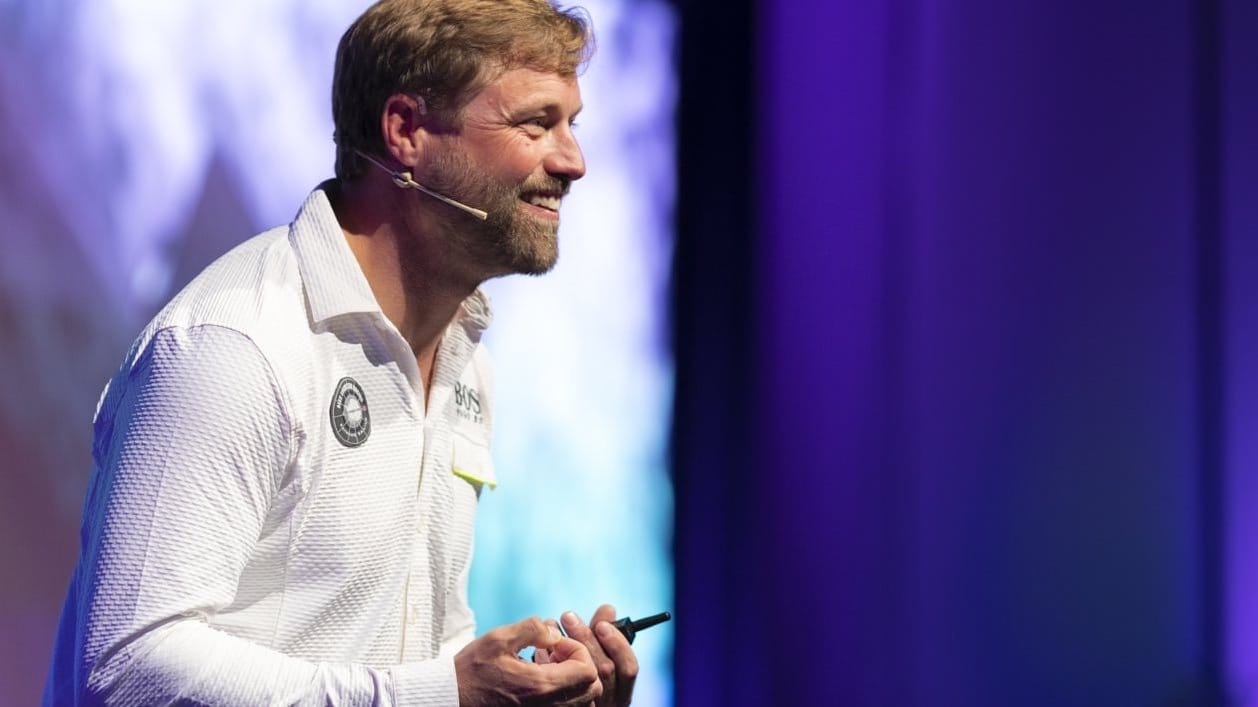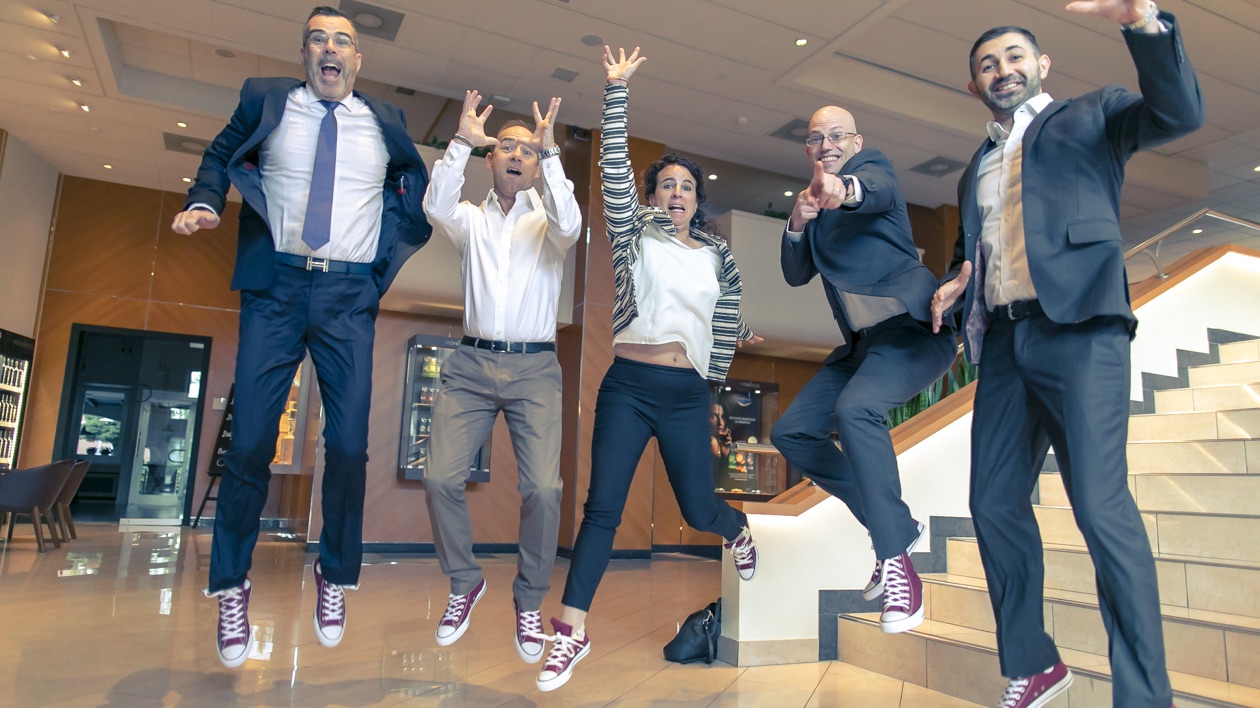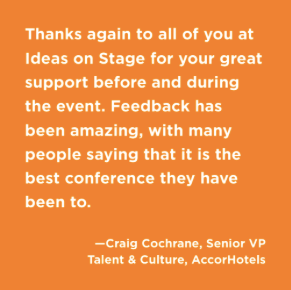Case study of Mövenpick Hotels & Resorts’ 2018 General Managers conference in Regensdorf, Switzerland.

__
The Story
It was a cool September morning in Paris when my colleague and I sat down in a stylish hotel dining room to meet a Mr. Olivier Chavy, President of Mövenpick Hotels & Resorts.
Before 8:00am we jumped right into business: Olivier’s vision and objectives for the spring 2018 general managers conference. “We want people to leave with the sensation ‘wow, I am really proud to work for this company’,” emphasized Chavy.
We asked a lot of questions about his motivation and the current state of the company. Ultimately, we were talking about inspiring a shift in culture. We gathered as much information as we could before wrapping up the meeting with quick sips of coffee to match Chavy’s speedster-pace.
This is how the project started — for us. But Chavy and his team had kicked-off planning the conference that summer, more than 8 months before the event would take place. Not everyone starts this well in advance. But let me assure you, it pays off.
At Ideas on Stage, we’ve had the pleasure of helping clients from practically all sectors bring creative and substantial presentations and events to life many times over. This was going to be a fun challenge given how out-of-the-box the client wanted to be in achieving the fundamental goals: inspire employee pride, reignite team unity and accelerate innovation to succeed in today’s world. Fueled up, we sent Chavy a proposal for our plan forward. He agreed and we put pedal to the metal.
The Challenge

Normally, we need to consider some or all of the following elements in designing an event: budget, location, scheduling, possible discrepancies between organizers’ objectives and audience needs, overcoming bad presentation habits like death-by-PowerPoint, and harmonizing key messages across speakers and workshops.
For Mövenpick’s conference, our top risk was message-related. We needed to step out of ‘business as usual’, while not overstretching general managers’ sensibilities to create a snap-back. GMs impact everything from sales to front-office operations, so we needed to avoid the risk of destabilizing them and in turn, their team and guests. We needed to strike a warm tone with a clear ‘why’ supporting the call for a shift in culture. We needed to be glued to the question: what (in this culture shift) is in it for them?
The managers were coming from all around the world, an array of cultures and in many cases a relatively classic business paradigm. So, how would we effectively disrupt older assumptions and enroll them in an update across all touch-points in their hotels?
There were also scheduling and location constraints. Plus, conflicting conferences happening in the same time period, which GMs would need to attend. So how did we mitigate said risks and optimize opportunity in our planning?


The Solution
Step one: align key stakeholders. To do this, we facilitated a full-day brainstorm in Geneva with their executive committee, or I should say, both of them. Chavy had recently engaged a shadow ExCom-Y team powered by millennials. During this synergistic gathering, Phil Waknell and I took the diverse group through Ideas on Stage methodology to synchronize objectives, distill key messages and capture creative ideas.

There were many questions to be asked, but first things first: we always start with our ABCs; of course I don’t mean the alphabet. We begin by gathering all there is to know regarding the specific Audience — the GMs in this case; their Burning Needs — what did they need out of this conference? And the Context — where and when exactly will the conference take place? Audience, Burning Needs, Context.
Since that full day in Geneva it was clear we were working with a special group. Chavy and his team were not just talking about transformation, they were walking the change. To assure highest impact, they decided it was worth bringing in an external partner to keep things on target and provide fresh insight.
The day wrapped up with a succulent dinner in the heart of Geneva. (Mövenpick knows how to tie everything together with a beautiful moment.) This kind of generosity and attention to detail wove throughout the next 6 months until the final applause at the end of their conference.
Between that day and the event on April 25th, many steps were taken to ensure the success of this event. Here are the super six takeaways which you can put into practice now:
- Define a clear objective and tie it together with a theme. We decided early on about larger organizing elements, such as the theme of the conference, which would harmonize our main objective across a full 3-day line-up of presentations and workshops. We needed something that would inspire an internal culture change towards being faster, more connected, performance-oriented and having fun. A theme for rethinking the possible and changing gears with changing times. The theme: “SHIFT 2018”
- Add an inspirational gem. We gathered candidates for external speakers that would elevate our theme and draw insightful real-world connections. Who would represent best-in-class performance, efficiency, collaboration and all with a heart-pumping story of optimism and appetite for adventure? The speaker: ace solo sailor Alex Thomson, 2nd place Vendée Globe Champion
- Schedule and sync with presenters well in advance. To be sure all workshops and presentations were coherent, unique, memorable and impactful, we scheduled on average two hours of coaching with each contributor, of which there were a good 30 across the 2-day agenda. There were TED-inspired keynotes, panels, a live press briefing (one of the client’s many brilliant ideas), interactive workshops, and 10min lightning talks. The success of an event is determined before it begins. Given the packed agenda and the client’s commitment to success, we deployed the needed resources: two Speaker Coaches, a Master of Ceremonies, plus a Design Director all onsite for the entire event including rehearsals the day before. The takeaway: You can’t prepare too early, too well, or too much.
- Sprinkle on special touches. From the moment participants arrived the night before they were greeted with thoughtful gifts in their rooms, including products they were being asked to adopt in their hotels. There was also a surprise pair of Converse sports shoes, in the right size, which the normally shined-shoe crew were certainly not expecting. They were told that without their sneakers they couldn’t take a step into the conference. This was a true hit and left a memorable impression on everyone as a symbolic feature representing their unity as a team, accentuating the need for speed and fun. Other high-end touches included shifting gears on two F1 simulators, test-riding a pair of TESLA driverless cars and, to conclude the conference, an afternoon treasure-hunt that sent the whole 130-plus international pack out into the streets of Zurich to explore Movenpick’s Swiss roots at a competitive pace. The reviews: they laughed, they played, and they performed as a united global team.
- Add the unexpected. Make it memorable by making it meaningful, different and fun. Not every company or event will have a budget to offer gifts or to eat gourmet food and sip coffee-cocktails during breaks. However, that shouldn’t stop you from offering new experiences or thoughtful touches that “make moments” for your participants that are authentic to your culture. The tip: consider what matters to your team, then be generous.
- Visuals matter. Slide design and space were key in the success of this event. Too many conferences invest time and money in other important areas but forget the essential role of visuals to support key messages on stage. Movenpick limited text to under 10words/slide and asked presenters to make decks as graphic, clear and simple as possible. When speakers needed a creative boost, we were there to design and animate with them. The key: visuals matter, from slides to attire and certainly the event space.

Speaking of the actual space, Movenpick broke the mold and accentuated their culture shift within their hotel design by putting participants in a more modern yet homey setup. Couches and armchairs replaced stiff banquet seating, reflecting the future feel of their lobbies.
Events are not brain science. It’s about starting early and being thorough from the bottom to the top. You need the right materials and a clear plan to build a masterpiece.
Involve key stakeholders. Work from your core objectives and add layers of meaning and originality in stages. Above all, stay true to who you are as an organization. Authenticity is key.
One more thing. What made Movenpick’s SHIFT 2018 conference truly amazing, was that the leadership team and organizers continuously put themselves in the shoes of their audience: the GMs. They thought from their perspective and their needs. Serve your audience and you will smile at the results.
Chavy’s event team took risks to walk their talk: they were honest, dynamic and prepared enough to let loose on D-Day. It was clear that they were proud to work at Movenpick, and that pride was reflected in their audience.
So, in organizing your next event, we hope you feel clearer and more inspired about how to approach it. And, if you’d like some experienced partners to help guide you on the journey, you know where to find us.


The Results
Here is a brief interview with Olivier Chavy two weeks after SHIFT 2018:
How did you feel the event went from a leadership perspective? The overall atmosphere of the conference was what we were most interested in and we wanted people to leave with the sensation ‘wow, I am really proud to work for this company’. The reactions we have received so far lead us to believe this was a mission accomplished!
What did your general managers have to say about the event? The most common feedback has been that this was the best GM conference they have ever attended, which is fantastic. Most delegates commented that they liked the unusual format of short, sharp sessions – not too long sitting in a hall and no numbers presented.
What made SHIFT a memorable experience? The whole ambiance made it memorable but there were a lot of memorable ‘little touches’ that came together to achieve this. From everyone wearing Converse high top shoes, to the newspaper we created, to the cool partners who presented, to the Swiss cow-bell awards…. We took some risks and did things differently and it paid off.
When did you start planning the conference and why did you bring in Ideas on Stage to support you? We started planning initially in summer 2017 but the real work began in October/November that year. We decided to bring Ideas on Stage on board as we knew we didn’t want to do a ‘traditional’ conference and we would need professional assistance to stage manage, coach our speakers and plan the sessions.
How did working with Ideas on Stage help in realizing the event? It was critical – we would not have achieved the impact we did without them. Every one of our speakers was coached and guided into how to make the most of their session, all content was aligned to ensure the messages we wanted were passed, they came up with great ideas for transitions, flow of sessions, themes. We are really pleased we brought them on board.
Were you surprised by any aspect of the event, before, during or after? We were surprised that we could enjoy it and not stress too much, it went really smoothly.


